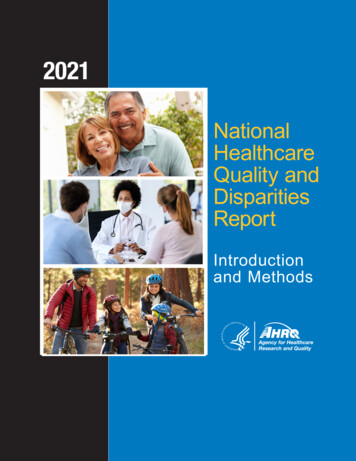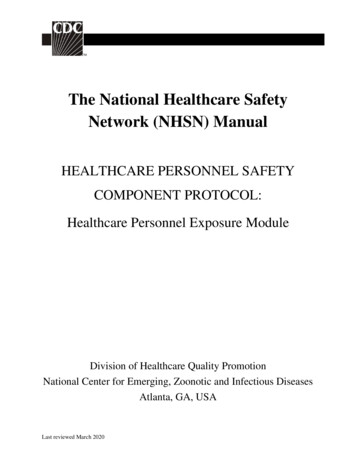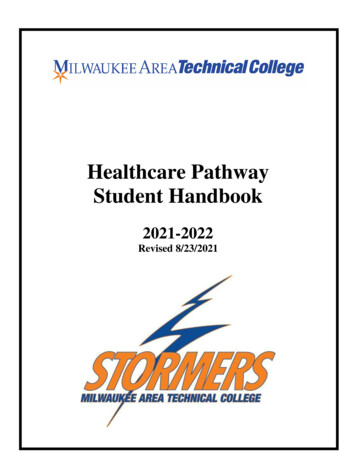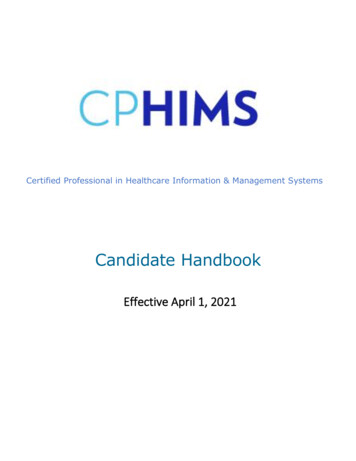
Transcription
2021NationalHealthcareQuality andDisparitiesReportIntroductionand Methods
This document is in the public domain and may be used and reprinted without permission.Citation of the source is appreciated.Suggested citation: 2021 National Healthcare Quality and Disparities Report Introduction andMethods. Rockville, MD: Agency for Healthcare Research and Quality; December 2021. AHRQPublication No.21(22)-0054-EF.
2021 National Healthcare Quality and Disparities ReportIntroduction and MethodsU.S. DEPARTMENT OFHEALTH AND HUMAN SERVICESAgency for Healthcare Research and Quality5600 Fishers LaneRockville, MD 20857www.ahrq.govAHRQ Publication No. 21(22)-0054-EFDecember index.html
ACKNOWLEDGMENTSThe National Healthcare Quality and Disparities Report (NHQDR) is the product of collaboration amongagencies from the U.S. Department of Health and Human Services (HHS), other federal departments, andthe private sector. Many individuals guided and contributed to this effort. Without their magnanimoussupport, the report would not have been possible. Specifically, we thank:Primary AHRQ Staff: David Meyers, Jeff Brady, Erin Grace, Karen Chaves, Darryl Gray, BarbaraBarton, Romsai Boonyasai, Irim Azam, Cecilia Hahn, and Doreen Bonnett.HHS Interagency Workgroup (IWG) for the NHQDR: Girma Alemu (HRSA), Irim Azam (AHRQ),Andreea Balan-Cohen (IMPAQ), Barbara Barton (AHRQ), Doreen Bonnett (AHRQ), Deron Burton (CDC),Victoria Chau (SAMHSA), Karen Chaves (AHRQ), Xiuhua Chen (Atlas Research), Deborah Duran (NIHNIMHD), Melissa Evans (CMS), Camille Fabiyi (AHRQ), Darryl Gray, (AHRQ), Kirk Greenway (IHS),Sarah Heppner (HRSA), Ed Huff (CMS), DeLoris Hunter (NIH-NIMHD), Susan Jenkins (ACL), ChristineLee (FDA), Doris Lefkowitz (AHRQ), Jesse Lichstein (HRSA), Lan Liang (AHRQ), Shari Ling (CMS), IrisMabry-Hernandez (AHRQ), Marlene Matosky (HRSA), Tracy Matthews (HRSA), Christine Merenda(FDA), Kamila Mistry (AHRQ), Ernest Moy (VHA), Samia Noursi (NIH-NIDA), Kathy O’Connor (CDC),Rajasri Roy (NIH-OD-ORWH), Dianne Rucinski (OASH), Asel Ryskulova (CDC), Adelle Simmons(ASPE), Robin Streeter (HRSA), Loida Tamayo (CMS), Caroline Taplin (ASPE), Emmanuel Taylor (NIHNCI), Michelle Washko (HRSA), and Ying Zhang (IHS).NHQDR Team: Irim Azam (CQuIPS), Barbara Barton (CQuIPS), Doreen Bonnett (OC),Romsai.Boonyasai (CQuIPS), Xiuhua Chen, (Atlas Research), James Cleeman (CQuIPS), Camille Fabiyi(OEREP), Erin Grace (CQuIPS), Darryl Gray (CQuIPS), Cecilia Hahn (CQuIPS), Lan Liang (CFACT),Kamila Mistry (OEREP), Margie Shofer (CQuIPS), Abigail Woodroffe (IMPAQ).HHS Data Experts: Cuong Bui (HRSA), Lara Bull (CDC), Robin Cohen (CDC-NCHS), Joann Fitzell(CMS), Elizabeth Goldstein (CMS), Shiromani Gyawali (SAMHSA), Irene Hall (CDC-HIV), PradipMuhuri (AHRQ), Jessica King (NPCR), Amanda Lankford (CDC), Denys Lau (CDC-NCHS), Lan Liang(AHRQ), Sharon Liu (SAMHSA), Marlene Matosky (HRSA), Tracy Matthews (HRSA), Robert Morgan(CMS), Richard Moser (NIH-NCI), Kathy O’Connor (CDC-NCHS), Krishna Palipudi (SAMHSA),Robert Pratt (CDC), Asel Ryskulova (CDC-NCHS), Alek Sripipatana (HRSA), Reda Wilson (CDCNCCDPHP-ONDIEH), and Xiaohong (Julia) Zhu (HRSA).Other Data Experts: Mark Cohen (ACS NSQIP), Ashley Eckard (University of Michigan), SheilaEckenrode (MPSMS-Yale), Clifford Ko (ACS NSQIP), Vivian Kurtz (University of Michigan), LeticiaNogueira (American Cancer Society), Robin Padilla (University of Michigan KECC), Yun Wang(MPSMS-Yale), and Robin Yabroff (American Cancer Society).Other AHRQ Contributors: Cindy Brach, Edwin Lomotan, Karen Migdail, Pamela Owens, WendyPerry, Mary Rolston, Bruce Seeman, and Michele Valentine.Data Support Contractors: Atlas Research, IMPAQ International.
CONTENTSBackground on the National Healthcare Quality and Disparities Report and Related Chartbooks 1Changes to the National Healthcare Quality and Disparities Report. 22021 Report .2Changes to Past Reports.3Organization of the 2021 National Healthcare Quality and Disparities Report . 5Methods of the National Healthcare Quality and Disparities Report and Related Chartbooks. 6Measures.6Data Sources.8Populations .10Analyses .13Analysis Limitations .20Reporting Conventions . 26References . 27
INTRODUCTION AND METHODSThis Introduction and Methods document provides background on the annual NationalHealthcare Quality and Disparities Report (NHQDR) and modifications that have occurred overtime. This document includes an overview of the methods used to generate estimates, measuretrends, and examine disparities.Background on the National Healthcare Quality and Disparities Reportand Related ChartbooksFor the 19th year in a row, the Agency for Healthcare Research and Quality (AHRQ) hasreported on progress and opportunities for improving healthcare quality and reducing healthcaredisparities. As mandated by the U.S. Congress, the report focuses on “national trends in thequality of health care provided to the American people” (42 U.S.C. 299b-2(b)(2)) and“prevailing disparities in health care delivery as it relates to racial factors and socioeconomicfactors in priority populations” (42 U.S.C. 299a1(a)(6)).The NHQDR is produced with the support of a Department of Health and Human Services(HHS) Interagency Work Group (IWG)i and guided by input from AHRQ’s National AdvisoryCouncil and the Institute of Medicine (IOM), now known as the Health and Medicine Division ofthe National Academies of Sciences, Engineering, and Medicine.The 2021 report tracks about 230 healthcare process, outcome, and access measures, covering awide variety of conditions and settings. Data years vary across measures; most trend analysesinclude data points from 2000-2002 to 2013-2019. An exception is rates of uninsurance, whichare reported through 2021.Measures used in the NHQDR fall into two categories: Core measures are used in the main NHQDR, or “core report.” These summarize thestatus of overall quality, status of disparities, and trends in quality and disparities. Coremeasures are approved by the IWG for inclusion and are nationally representative.AHRQ receives these data regularly.Supplemental measures are not discussed in the core report, except to highlight importanttopical issues. Supplemental measures are typically new measures and/or have limiteddata availability. These measures have not been approved by the IWG for inclusion in thecore measure set and core measure summary analyses.Both categories of measures are available in the Data Query Tool.Federal participants on IWG: AHRQ, Administration for Children and Families, Administration for CommunityLiving, Assistant Secretary for Planning and Evaluation, Centers for Disease Control and Prevention, Centers forMedicare & Medicaid Services, Food and Drug Administration, Health Resources and Services Administration,Indian Health Service, National Institutes of Health, Office of the Assistant Secretary for Health, Substance Abuseand Mental Health Services Administration, and Veterans Health Administration.i2021 National Healthcare Quality and Disparities Report1
Introduction and MethodsChanges to the National Healthcare Quality and Disparities ReportThe NHQDR was significantly shaped by several IOM reports. Two of these reports, Crossingthe Quality Chasm1 and To Err Is Human2 raised awareness about gaps in the quality ofhealthcare and patient safety. The extensive literature review included in a third report, UnequalTreatment,3 drew attention to disparities in the care rendered to racial and ethnic populations,low-income populations, and other vulnerable groups.Since the report’s inception as the National Healthcare Quality Report (NHQR) and NationalHealthcare Disparities Report (NHDR) in 2003, AHRQ has worked over time to enhanceand refine the NHQDR measure set and methodology. These enhancements includeintroducing core measures and composite measures and refining the methods of analysis. Inaddition, the area of patient safety was expanded to include sections on healthcare-associatedinfections and patient safety culture. The NHQDR team also added sections on lifestylemodification and care coordination.In response to IOM recommendations, the NHQDR team produced a single Highlights chapterthat integrated findings from the NHQR and NHDR. In addition, we introduced measure-specificbenchmarks that reflect the high level achieved by the best performing states. To address thethree quality improvement aims of better care, healthy people, and affordable care (also knownas the Triple Aimii), we organized the reports into six priority areas (e.g., Patient Safety, HealthyLiving) that could help achieve the three aims.In 2014, the NHQR and NHDR were combined to provide a more complete and integratedassessment of access to and quality of healthcare, as well as disparities. The new NHQDR alsoincluded measures related to other key populations, including women, children, older adults,people with disabilities and at the end of life, and residents of rural areas and inner cities.This section covers major changes to the report and summarizes data updates in reversechronological order, beginning with most recent.2021 ReportNew FeaturesTrend analyses and changes in disparities results are not summarized by priority area and bysubgroup because about 26% of the 233 core measures do not have at least 4 years of data fortrending. A total of 41 core measures from the Healthcare Cost and Utilization Project (HCUP)data are excluded from trending. Due to the transition from International Classification ofDiseases, Ninth Revision (ICD-9) to Tenth Revision (ICD-10) coding standards, 6 HCUPmeasures were terminated, and the 41 measures only have 2016-2018 data for the 2021 report.Only two measures have sufficient data for trending.More information on the Triple Aim is available from the Institute for Healthcare Improvement Pages/default.aspx.ii22021 National Healthcare Quality and Disparities Report
Introduction and MethodsEighteen measures from the Medical Expenditure Panel Survey (MEPS) data are excludedbecause of the 2018 MEPS redesign. Eight National Health Interview Survey (NHIS) measuresare excluded from trending because of the 2019 NHIS redesign. More details can be found belowin the “Analysis Limitations” section.Bar charts showing disparities between populations will also include data of all subgroups withinthe same population category, even when the data for a subgroup do not show statisticallysignificant differences compared with the reference population.The “Disparities in Healthcare” sections feature the three measures where subgroups had thelargest disparities compared with the reference population. The results of these disparities analysesare presented in bar charts that display the rates for both the comparison and reference groups.In prior reports, the bar chart showing the largest disparities only included the total, the subgroupwith the largest disparities, and the reference population. The bar charts displayed in the currentreport, however, display all populations within that group. For example, for the measure HIVinfection deaths per 100,000 population, Blacks experienced the largest disparities comparedwith Whites. The current report not only features data for Blacks and Whites but also AmericanIndians and Alaska Natives and Asians. If data for a subgroup are not statistically reliable, a noteis added to the figure.Changes to Past ReportsNew Features in 2019The 2019 NHQDR had several new features that strengthen the reader’s understanding of accessto care, the healthcare workforce, and the NHQDR measure set.In the Overview section of the report, readers gained an understanding of the healthcarelandscape and utilization. Of note was a new subsection that examined racial and ethnicdisparities among the U.S. healthcare workforce. Multiple roles within the healthcare system,including nurses, physicians, therapists, and psychologists, are discussed and compared with theU.S. population.The Access section featured measures and data examining dental care accessibility, MedicareAdvantage patients, and dual-eligible beneficiaries. People with Medicare Advantage and thosewho are dually eligible for Medicare and Medicaid have unique accessibility concerns. The endof the Access section contains tables listing the trend performance (improving, not changing, orworsening over time) of each core measure.The Quality section of the report highlights the best and worst performing trends across each ofthe six quality domains featured in the NHQDR. In 2018, the authors reintroduced theAffordable Care section, which includes two measures that show improving trends over time.The report features more than 250 measures based on data availability in the 2019 NHQDR. Theend of each Quality subsection contains tables listing the trend performance (improving, notchanging, or worsening over time) of each core measure.2021 National Healthcare Quality and Disparities Report3
Introduction and MethodsBased on the quality domain, measures are categorized by sub-area or healthcare setting to helpreaders identify them. All figures in this year’s report have been embedded in the report and are nolonger featured in an appendix. In addition, notes below each figure assist with their interpretation.The Disparities section highlights differences in care experienced by priority populations. Thisyear’s report uses the National Institute on Minority Health and Health Disparities researchframework to better address the complexity of health disparities. Additional information aboutdisparities experienced by residents of rural areas is also highlighted. Measures with the largestdisparities by residence location are organized by priority area and care setting.Updates in Data Source Availability in 2019 Healthcare Cost and Utilization Project (HCUP) state data and trend data remainedunavailable for the 2019 report due to the change from ICD-9 diagnosis codes to ICD-10codes and changes to the AHRQ Quality Indicators (same as the 2018 report).Unlike the 2018 report, the 2019 report includes HCUP risk-adjusted benchmarks for someof the Quality Indicators.Behavioral Risk Factor Surveillance System data became available for the 2019 report andare included in all analyses.Medical Expenditure Panel Survey (MEPS) activity limitation data were not available for the2019 report. This variable has been replaced with disability status.The NHQDR dataset included data from the Centers for Medicare & Medicaid ServicesMinimum Data Set.New Features in 2018The 2018 NHQDR included a New Measures section that introduced new measures in four areasthat aligned with HHS priority areas and addressed gaps in the care continuum. These includednew measures for dementia, opioid prescribing, opioid-related deaths, maternal morbidity andmortality, and cancer treatment.Updates in Data Source Availability in 2018 The “Opioids” section was new for the 2018 report. The 2018 report has eight opioidmeasures; two are core measures and five are supplemental measures. These measures comefrom multiple data sources (HCUP, MEPS, National Vital Statistics System, and NationalSurvey on Drug Use and Health). The NHQDR dataset now includes data from the Centers for Medicare & Medicaid Services,Outcome and Assessment Information Set.Data Limitations and Changes Before 2018, the NHQDR had about 50 core measures using HCUP data. However, theHCUP state data and trend data were not available for the 2018 report due to the change fromICD-9 diagnosis codes to ICD-10 codes and changes to the AHRQ Quality Indicators. Data for about 20 nursing home care measures and 30 home health care measures were notavailable for the 2016 and 2017 reports. For the 2018 report, 2013-2016 data were availableand were included in the comparisons and trend analyses.42021 National Healthcare Quality and Disparities Report
Introduction and Methods Since 2016, the NHQDR team has been working to make the analysis methods and resultsconsistent between the NHQDR website and the reports. However, inconsistencies still exist.For 2018, nursing home data became available after the report was prepared, so they werenot included there but were included in the website data analysis. In addition, because theopioid crisis is an HHS priority, we included all data for the opioid supplemental measures inthe website data analysis even though only two measures were included in the report.The benchmark year for the 2018 report did not move forward by 1 year. In previous years,the benchmark year usually moved forward. The benchmark year was 2014 for the 2016report and 2015 for the 2017 report. For 2018, the benchmark year was still 2015. Therefore,there were more measures, states, and subgroups that reached the benchmark in the 2018report than in previous years.Organization of the 2021 National Healthcare Quality and DisparitiesReportThe 2021 report and chartbooks are organized around the concept of access to care, quality ofcare, disparities in care, and six priority areas, including person-centered care, patient safety,care coordination, affordable care, effective treatment, and healthy living. The report includessummaries of the status of access, quality, and disparities. Details for individual measures areprovided in the appendixes.The report presents information on trends, disparities, and changes in disparities over time, aswell as federal initiatives to improve quality and reduce disparities. It includes the following: Overview of U.S. Healthcare System Landscape describes the healthcare system,encounters, and workers; disease burden; and healthcare costs.Access to Healthcare and Disparities in Access tracks progress on making healthcareavailable to all Americans.Trends in Quality of Healthcare tracks progress on ensuring that all Americans receiveappropriate services.Disparities in Healthcare tracks progress in closing the gap between minority racial andethnic groups and Whites, as well as income and geographic location gaps (e.g.,rural/suburban disparities).Looking Forward summarizes future directions and research opportunities forhealthcare quality and measurement initiatives.Additional information on each measure can be found in the Data Query section of the NHQDRwebsite (https://datatools.ahrq.gov/nhqdr). Below each table generated are links to: Data Source, which provides information about each database analyzed for the report,including data type, sample design, and primary content. The list of data sources isavailable in Appendix A.2021 National Healthcare Quality and Disparities Report5
Introduction and Methods Measure Specifications, which provide information about how measures are generatedand analyzed for the report. Measures highlighted in the report are described, as well asother measures that were examined but not included in the text of the report. The measurespecifications are also available on the NHQDR web page.Methods of the National Healthcare Quality and Disparities Report andRelated ChartbooksMeasuresAccess to Healthcare Purpose. Assess access to care for the overall U.S. population and priority populations;identify racial, ethnic, and socioeconomic disparities; track changes in access to care over time;and identify aspects of access to care that are improving and aspects that are not improving. Approach. Factors that facilitate accessing healthcare, including having health insurance anda usual source of care, have been tracked since the first reports. Measures of timeliness ofcare and infrastructure to provide healthcare to minority and low-income populations wereadded to the access measure set. Summaries of Access. At times, the report will present summary information across a panelof access measures, including measures widely considered important for accessinghealthcare, such as getting care in a timely manner.The access measures panel excludes measures with less clear interpretation. For example,increases in the percentage of people under age 65 with any period of public insurance during theyear may indicate people lost their private insurance, which is undesirable. On the other hand,they obtained public insurance coverage, which indicates access to some form of healthinsurance is improving.Similarly, use of emergency departments as a usual source of care is not included in the accessmeasures panel, because rising rates have multiple interpretations. They could reflect meeting apreviously unmet community need, which would be desirable, or problems getting care inprovider offices, which would be undesirable. Researchers, policymakers, and other users shouldexplore these data further to understand the underlying causes.Quality of Healthcare Purpose. Assess quality of care for the overall U.S. population and priority populations;identify disparities among racial, ethnic, and socioeconomic groups; track changes in qualityof care over time; and identify aspects of quality of care that are improving and aspects thatare not improving.Initial Approach. The selection of quality measures to include in the first reports involvedseveral steps: IOM provided criteria for the selection of quality measures in 2001: overall importanceof the aspects of quality being measured, scientific soundness of the measures, andfeasibility of the measures. It also provided criteria for the measure set as a whole:balance, comprehensiveness, and robustness.62021 National Healthcare Quality and Disparities Report
Introduction and Methods IOM and AHRQ issued calls for measures that yielded hundreds of measures submittedby private and governmental organizations. A Federal Measures Workgroup was convened to apply the IOM criteria to the measuressubmitted for consideration. A preliminary measure set was published in the Federal Register for public comment;additional comments were obtained through a hearing organized by the NationalCommittee on Vital and Health Statistics. In 2003, this process yielded an initial measure set that included 147 measures from twodozen data sources. Types of Quality Measures. Most measures tracked in the report reflect processes of care,outcomes of care, and patient perceptions of care: Processes of Care. These measures generally represent percentages of people receivingcare that they need or percentages of people receiving care that they should not receive.Measures are specified so that everyone in the denominator needs the service and optimalcare equals 100%. These measures are generally not adjusted for age and sex since needis captured in the specification of the denominator. Outcomes of Care. These measures generally represent rates of adverse events or deaths.Because death rates often reflect factors other than healthcare, only death rates withmoderate ties to processes of care are tracked. For example, colorectal cancer death ratesare tracked because they are related to rates of colorectal cancer screening. Patient Perceptions of Care. These measures generally represent percentages of peoplewho perceived problems with aspects of their care. Refinement of the Measure Set. Since the first reports in 2003, the measure set has beenreviewed each year and changes made as needed. All changes are approved by the HHS IWGthat supports the NHQDR. Additions have been made to the measure set as new domains of quality, data, andmeasures have become available. For example, Care Coordination and Affordable Carewere not recognized quality domains when the reports started, and measures of thesedomains were identified and added after they were recognized. Deletions have been made when data collection for measures ceased or when newscientific information indicated that a measure did not represent high-quality care. Inaddition, process measures that achieve overall performance levels exceeding 95% arenot tracked in the report. The success of these measures limits their utility for trackingimprovement over time. Because these measures cannot improve to a significant degree,including them in the measure set creates a ceiling effect that may dampen quantificationof rates of change over time. Data on retired measures continue to be collected and thesemeasures will be added back to the report if their performance falls below 95%. Modifications have been made when clinical recommendations have changed. Forexample, clinical recommendations often set new target levels or recommendedfrequencies for specific services.2021 National Healthcare Quality and Disparities Report7
Introduction and Methods Summaries of Quality. At times, the report will present summary information across a panelof quality measures. This panel includes measures that are widely considered important forhealthcare quality, such as measures of processes, outcomes, and patient perceptions, asnoted above. The panel excludes measures with less clear interpretation, typically measuresof infrastructure and costs.Data SourcesOverview of DataThe data included in the report were determined by the measures chosen for tracking by the IWGand the NHQDR team. The report is based on dozens of data sources to provide acomprehensive assessment of access to healthcare and quality and disparities of healthcare in theUnited States. Most are nationally representative or cover the entire U.S. population.Different types of data are used to provide complementary perspectives of healthcare andinclude patient and population surveys, provider surveys, administrative data from facilities,medical records, registries, surveillance systems, and vital statistics. Settings of care coveredinclude ambulatory care, health centers, emergency departments, hospitals, nursing homes,hospices, and home health.Data experts from contributing agencies or organizations generate descriptive summary statisticsfrom the micro data for the NHQDR measures and population groups of interest. For particularmeasures, the NHQDR team downloads summary statistics directly from trusted websites.All survey design features are taken into account. The percentages or rates are weighted torepresent the targeted population. Statistics with a sample size of fewer than 30 individuals orrelative standard errors larger than 30% are suppressed for statistical reliability, data quality, orconfidentiality. The suppression criteria are different by data source and mostly are decided bythe NHQDR contributing agencies. If the contributing agencies did not suppress any data, theNHQDR coded the data to “DSU” (data statistically unreliable) if the sample size was 30 or therelative standard error was 30%.The NHQDR team has maintained and accumulated the data since 2003, the first year of thereports. Some survey designs, questionnaires, data collection methods, definitions, and datacalculation methods have changed over the years. The team and the agencies contributing dataworked together to address the changes and to ensure that data over the years were comparablefor trend analysis.Some contributing agencies updated all of the back years’ data if possible, such as MedicalExpenditure Panel Survey (MEPS) data, or removed all back years’ data, such as HealthcareCost and Utilization Project (HCUP) data. Some contributing agencies informed the team aboutthe changes, provided recommendations, and adjusted the measures, or removed thenoncomparable data from the database. Data are kept if the changes are considered minor and donot significantly affect the estimates.82021 National Healthcare Quality and Disparities Report
Introduction and MethodsOnly data sources that are regularly included in the report are listed below. Not included on the listare sources that do not collect data on a regular basis; such data are presented intermittently in thereport when they address topics or populations not well covered by regular data collections.Federal Sources of DataAgency for Healthcare Research and Quality Healthcare Cost and Utilization Project (HCUP)Medical Expenditure Panel Survey (MEPS)CAHPS Database – CAHPS Health Plan Survey DatabaseCenters for Disease Control and Prevention Behavioral Risk Factor Surveillance System (BRFSS)HIV/AIDS Surveillance System (HIVAIDSSS)National Ambulatory Medical Care Survey (NAMCS)National Electronic Health Records Survey (NEHRS)National Health and Nutrition Examination Survey (NHANES)National Health Interview Survey (NHIS)National Hospital Ambulatory Medical Care Survey (NHAMCS)National Immunization Survey (NIS)National Program of Cancer Registries (NPCR)National Tuberculosis Surveillance System (NTSS)National Vital Statistics System—Linked Birth and Infant Death Data (NVSS-L)National Vital Statistics System—Mortality (NVSS-M)National Vital Statistics System—Natality (NVSS-N)Centers for Medicar
2021 National Healthcare Quality and Disparities Report Introduction and Methods .










